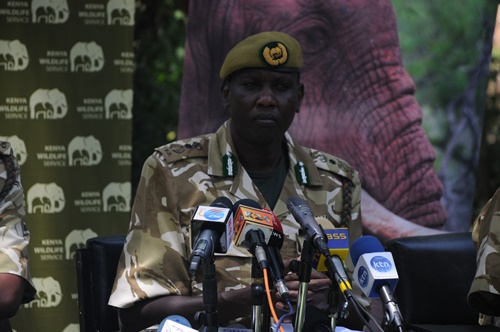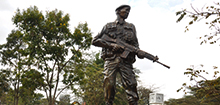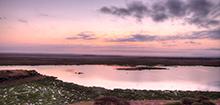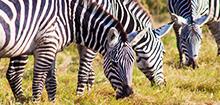
Date Published: 09 Feb, 2015
February 5, 2015
KWS statement on status of wildlife conservation in Kenya
Ladies and Gentlemen,
Thank you for honouring our invitation for this press conference. Happy New Year to you all, though a bit late, and welcome to Kenya Wildlife Service.
Human Wildlife Conflict
I wish to begin by offering my sincere condolences to the family and friends of the late Mr Saitoti Santamu Oleku in Kajiado, who was killed by an elephant. As KWS and indeed the government, we are saddened by human injuries and loss of lives occasioned by elephants. We are reviewing the situation to ensure this is prevented as is humanly possible.
In addition to our mapped out hotspots that include Tsavo East/West, Lamu, Laikipia, Narok/Trans Mara, new areas have emerged in Makueni and Kajiado counties. We have deployed rangers to respond to reports in these areas.
We have recalled our staff from leave to beef up the teams on the ground besides the use of our specialised team, the Problem Animal Management Unit (PAMU). I am glad to report that we are in the process of recruiting Community Wildlife Scouts to help in monitoring wildlife movements to pre-empt possible human wildlife conflict during this dry season.
To address specific concerns in Kajiado County, we plan to implement the following measures: dig new water-pans for wildlife in Eselenkei and scoop three community water pans in Maruesh and Imbuko area in the next three weeks.
Community Outreach
We are committed to continued engagement with communities. This year, we are investing heavily in providing community project interventions and building wildlife barriers to mitigate human wildlife conflicts. Besides, we shall continue engaging communities in dialogue and education and outreach programs.
To further empower local communities, KWS is on the forefront and as part of Kenya’s team working on the framework to domesticate the Nagoya Protocol on Access and Benefit sharing of genetic resources. We look forward to a future when our communities will benefit from the rich genetic resources in their localities.
Current dry weather conditions
As you are aware, most of Kenya is experiencing extreme dry weather conditions. We are conscious of escalating threats of fire and eventual habitat degradation. We have in the recent past experienced wild fires across wildlife protected areas including, Mt. Kenya, Aberdare, Ruma, Lualenyi Ranch area in Tsavo, Chepkitale, Mt. Elgon, Shimba Hills, Dodori, Boni and Tana Primate Reserve. All these incidents have been contained.
I have instructed officers in all protected areas to re-grade firebreaks as part of fire season preparedness. We have also procured and deployed water jets and water mists equipment for use in our conservation areas across the country.
Status of Wildlife Crime
As is the general trend globally and in the region, we are witnessing an emergence of new challenges in wildlife security. Wildlife crime has evolved over time and the situation is presenting increased challenges to wildlife conservation in the country.
In the recent past, wildlife crime has been exacerbated by climate change, human population pressure and dynamics in the global economic order. Growing affluence and economic growth in East and South-East Asia contributed immensely to increased demand for rhino and ivory. The rising demand and price of ivory and rhino horn in the illicit market continues to drive poaching. Consequently, Kenya’s wildlife (rhinos, elephants and the large cat family) are among the contraband products driving illegal wildlife trade globally.
Poaching has become more organized, sophisticated and international in nature and is occurring across all their ranges including in those areas that were hitherto considered safe havens. Proliferation of small arms in the region and in the illegal hands of citizens in areas hosting wildlife is a big threat to the security of wildlife as these weapons are used in poaching in addition to committing other crimes. Poachers are now using poison arrows to kill elephants – which is a silent and dangerous method of killing elephants as it is not easy to detect.
Available evidence indicates that the years 2011, 2012 and 2013 witnessed the highest levels of poaching since the poaching crisis of the 1980’s. For example, Kenya lost 47 elephants and 5 rhinos to poaching in year 2007 as compared to 384 and 30 in year 2012, and 302 elephants and 59 rhinos in year 2013 respectively. But we are glad that we are seeing some light at the end of the tunnel, thanks to concerted efforts by many stakeholders, including you. Last year, only 164 elephants and 35 rhinos were poached representing about 47 per cent and 40.7 per cent, respectively, representing a significant decrease from previous years. While these figures are indicative of the success of our concerted efforts, they still represent damage to our wildlife capital.
Furthermore, a total of 50 firearms and 616 rounds of ammunition and 5 tonnes of ivory were recovered during 2014. During the year, a total of 1,430 suspects were arrested and prosecuted for various wildlife law offences. This represents a 7.68 per cent decrease compared to the previous year which had 1,549 arrests. We have successfully prosecuted and secured convictions of up to 51 of the 306 cases handled by our officers within the provisions of the new law.
The highest penalty in 2014 was 9 years imprisonment with an option of a fine of Ksh. 20 million. Other cases are still pending before various courts of law across the country.
To enhance wildlife security, strengthen law enforcement and address wildlife crime, KWS has deployed specific security interventions. These strategies include:
- Identification, surveillance and profiling of trophy dealers.
- Arresting and prosecuting offenders.
- Active security operations to hunt down poachers.
- Establishment and strengthening of specialized security units which are deployed throughout the country.
- Deployment of Canine Unit at Jomo Kenyatta and Moi International Airports in Nairobi and Mombasa, respectively, to enhance detection of contraband ivory.
- Training and building the capacity of law enforcement personnel
- Formation and deployment of Inter-Agency Elite Anti -Poaching Unit in poaching hotspots
- Collaboration with other national security agencies and the regional Lusaka Agreement Task Force as well as cross border collaboration with other countries in the region.
- Reaching out to local communities to be partners in wildlife law enforcement
Internally, KWS is continuously building staff capacity to deal with these challenges. We also recruited and deployed additional 566 rangers to enhance wildlife security and enforcement actions. Several specialised training and equipment have been provided to security units to improve on their efficiency and effectiveness. While we await the commissioning of Forensic lab within the next couple of months, we are conducting forensic analysis to aid in crime scene management. Samples of various species, especially the key species have been collected for DNA profiling to assist in identification and monitoring of wildlife species. Very soon, this lab will aid in evidence gathering and securing convictions in courts of law.
Operationalization of the Wildlife Act 2013
The process of appointment of the Chairmen of County Conservation and Compensation Committees await the Ministry of Environment, Water and Natural Resources’ final selection. In the meantime, a consultant has been recruited to work on the formulation of the Regulations in relation to Access and Benefit sharing of the wildlife resources.
KWS has been part of the team working towards the formation of the proposed ‘Kenya Conservation Alliance’ aimed at ensuring that the wildlife industry in Kenya is organised to jointly and effectively confront the Conservation challenges in the country.
Space for Wildlife
It is noted that the Kenya Wildlife Conservancies Association (KWCA) has continued to help avail more of acres land for wildlife. About 7 million of acres of land has been set aside for wildlife conservation so far. We are also glad that the National Land Commission has been very supportive in helping secure Land under KWS previously claimed by land grabbers including Kisite Mpunguti Marine National Reserve and Mombasa Marine Park headquarters.
Staff welfare
We are continuing to improve the working environment for KWS staff, especially the rangers, by providing supplementary resources and skills through provision of allowances and training as well as providing supportive tools and equipment, with special emphasis on housing and transport.
Finally, we would like to assure all Kenyans and the world at large that KWS is up to the task of protecting our wildlife and we appeal for the co-operation of all citizens of the world in conservation.
Our duty remains to ‘save the last great species and places on earth for humanity’.
We wish to extend our invitation to celebrate the upcoming World Wildlife Day on 3rd March 2015, and extend gratitude to KWS staff and particularly rangers, our stakeholders and communities for their work and support during 2014.
We look forward to a better 2015.
William K. Kiprono
Ag. Director General





